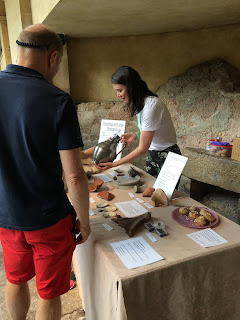 |
| Learn about Roman bread with Laura! |
“Two things only the people desire: bread, and the circus games.” Juvenal
Have you ever baked your own bread? Maybe. Ground your own
flour by hand? Less likely. Why not use the current situation and improve your
skills, learn something new and connect to the past. Bread has been a
staple food in many parts around the globe for thousands of years. The same
goes for the Romans who indeed seem to have been quite fond of bread, but how do
we actually know this?
Not only do we have recipe books and letters about diets
but also architectural remains of granaries and baker shops as well as environmental
samples from archaeological excavations that can be analysed.
While milling became more industrial when the Romans arrived in Britain – a large army and urban population needs to be fed – many households would grind their own flour to make their daily bread. Around Bath, we have found rotary hand querns that were used for that task.
 |
| A Roman rotary quern |
While this was more effective than pestle and mortar, it was still a strenuous hours-long task. No milling means no flour. No flour means no bread. And no bread could mean starvation.
Bread has been staple food for so long because it is a
sufficient source of energy. Flour contains starch which is broken down by
enzymes into glucose. During digestions this ultimately results in our bodies
being fuelled up to do what we love to do.
 |
| Baking Roman bread |
Have you ever wondered what makes bread rise though? Essentially, glucose is transformed into carbon dioxide (gas) which, trapped in the gluten network, expands and causes the dough to rise. If you feel like experimenting a bit, fill a glass half full with some warm water, add a spoon of caster sugar and a spoon of yeast. Stir, wait and watch what happens in the next hour.
The Romans in fact made many different kinds of bread,
leavened and unleavened. They seemed to have been very fond of spices as well.
Coriander or poppy seeds were particularly popular with bread. A commonly used
grain was spelt.
Why not have a go with this recipe?
 |
| Make your own Roman bread at home |
Spelt Bread Recipe
Ingredients
500g of spelt flour
300ml of warm water
7-10g of salt
~7g of quick action yeast
300ml of warm water
7-10g of salt
~7g of quick action yeast
Method
- Mix the dry ingredients in a mixing bowl, then add the water and knead the dough well for at least 5 minutes.
- Cover the bowl and leave to rise in a warm place for 1-2 hours, until the dough has doubled in size.
- Knead the dough thoroughly until smooth and leave to rise again.
- Preheat the oven to 220°C (200°C Fan), flour a casserole or loaf pan (make sure it is fit for oven use!) and put the dough into it.
- Bake in the oven for 40 – 50 minutes. (If baking in dish with a lid, leave the lid on for the first half, then remove for the second half).
- The bread is ready when it sounds hollow. Leave to cool down before removing it from the dish.
You can vary this recipe by mixing in honey, olive oil,
herbs, seeds, dried fruits or chopped nuts.
Bon Appetit!
Laura Opel
Learning & Programmes Placement




















